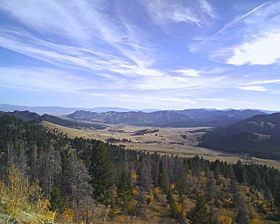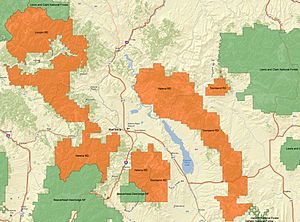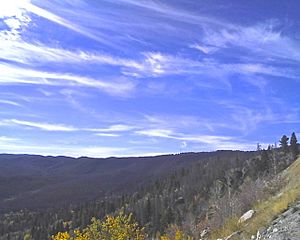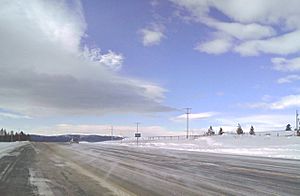MacDonald Pass facts for kids
Quick facts for kids MacDonald Pass |
|
|---|---|

MacDonald pass east side, looking into Lewis and Clark County
|
|
| Elevation | 6,312 ft (1,924 m) |
| Traversed by | |
| Location | Lewis and Clark / Powell counties, Montana, US |
| Range | Rocky Mountains |
| Coordinates | 46°33′41″N 112°18′31″W / 46.56139°N 112.30861°W |
MacDonald Pass, which is about 6,312 feet (1,924 meters) high, is a mountain pass in Montana. It crosses the Continental Divide west of Helena, Montana. U.S. Route 12 goes right over this pass. In the 1870s and 1880s, MacDonald Pass was one of three main routes used for travel between Helena and Deer Lodge, Montana. The other two passes were Mullan and Priest.
Contents
The Story of MacDonald Pass
Early Days and Toll Roads
In 1864, when Montana Territory was created, the government didn't have much money to build roads. So, they allowed "toll roads" to be built. A toll road is a private road where travelers pay a fee to use it. This helped shift the cost of road building to private companies.
The MacDonald road started as one of these toll roads. It was approved by Governor Green Clay Smith and built in 1867 by a French Canadian man named Constant Guyot. Guyot owned a hay ranch near Elliston, Montana.
The Frenchwoman's Road
At first, the road was known as "The Frenchwoman's Road." This was because Guyot's wife managed it. She also ran a hostel at the west end of the road, near Dog Creek. The hostel could sleep up to 30 men. Madame Guyot charged $2 to stay overnight and $1 for each meal.
In August 1868, Madame Guyot sadly passed away at the hostel. People believed the hostel was haunted by her ghost. Soon after, a local sawmill owner named Elijah M. "Lige" Dunphy bought the rights to the toll road. He hired a Canadian immigrant, Alexander "Red" MacDonald, to manage it. MacDonald made a deal with a stagecoach company, Gilmer, Salisbury and Company, to use the road. He also provided meals and lodging for travelers at the hostel.
Changing Hands and Public Roads
Between 1876 and 1877, MacDonald handed over the road's management to Valentine Priest. Priest later built his own competing road over Priest Pass in 1879. MacDonald then bought full ownership of the road from Dunphy in 1879. However, by 1885, fewer people were using the road, so MacDonald sold all his ownership in the toll road.
In 1889, after Montana became a state, Lewis and Clark and Deer Lodge Counties made both the MacDonald and Priest Pass routes public roads. This meant people no longer had to pay a toll. From 1889 to 1912, the MacDonald and Priest roads were not well-kept. Only the Mullan Pass route was maintained.
Modern Road Improvements
In 1912, Lewis and Clark and Powell County authorities worked with the Montana State Prison. They used prison labor to fix and improve the old MacDonald road. Through the 1920s, state and county officials discussed which road between Helena and Deer Lodge should be improved: Mullan Pass, Priest Pass, or MacDonald.
In 1927, the MacDonald road became part of the U.S. Federal Highway system. It was a section of U.S. Route 10 North. In 1931, the Montana Highway Department and the Federal Bureau of Public Roads funded a large project. They spent $89,000 to build a new road over MacDonald Pass. This project was finished in 1932, and the road was fully paved by 1935. In the 1970s, the road was made wider to four lanes.
Today, MacDonald Pass and U.S. Route 12 offer the shortest east-west highway connection. It links Helena to communities on Interstate 90, such as Anaconda and Missoula, and other places to the west.
Mountain Ration Training
On November 28, 1942, a special military group called the 1st Special Service Force tried out a new "Mountain ration" for the first time. This happened during a training exercise at MacDonald Pass.
The soldiers were testing how to live in winter conditions. They also tried out the new mountain food supplies. Groups of four soldiers built different types of shelters and fires. The Mountain ration came in four types. Each box had enough food for four men for three meals. This was often more food than an average person could eat! The rations included powdered soup and milk, canned meat and butter, cereal, chocolate, biscuits, compressed fruits, sugar, tea, coffee, and powdered lemon.




